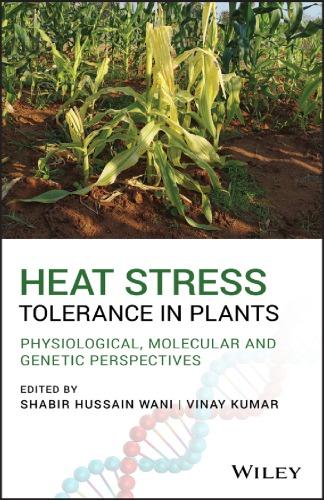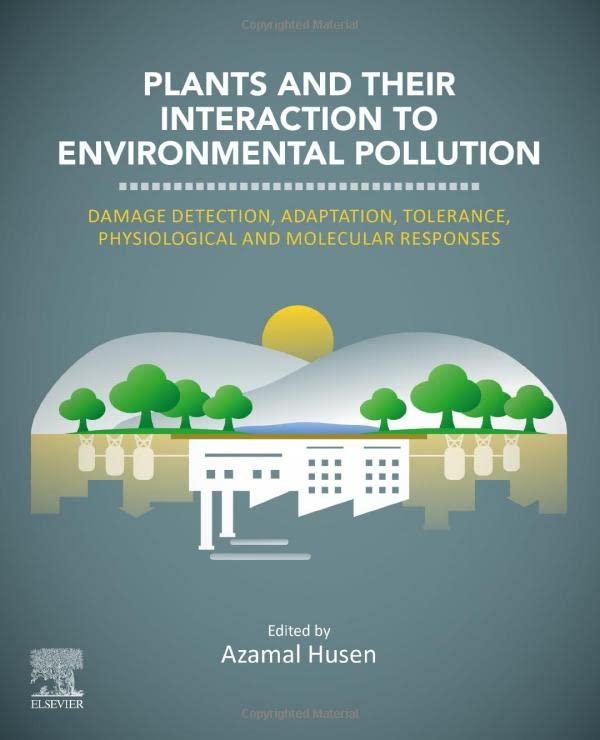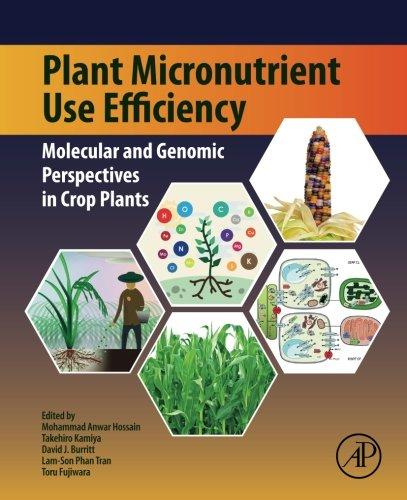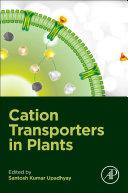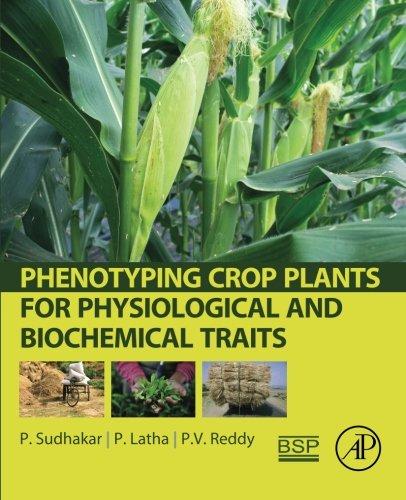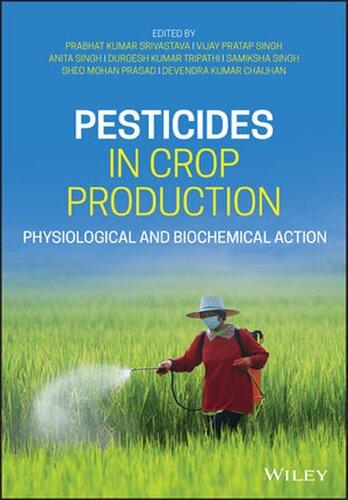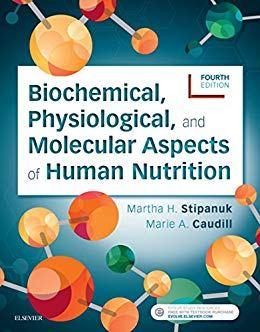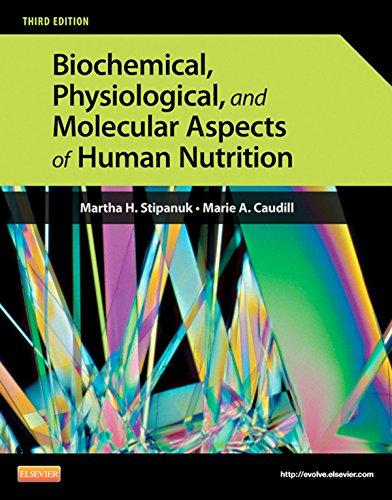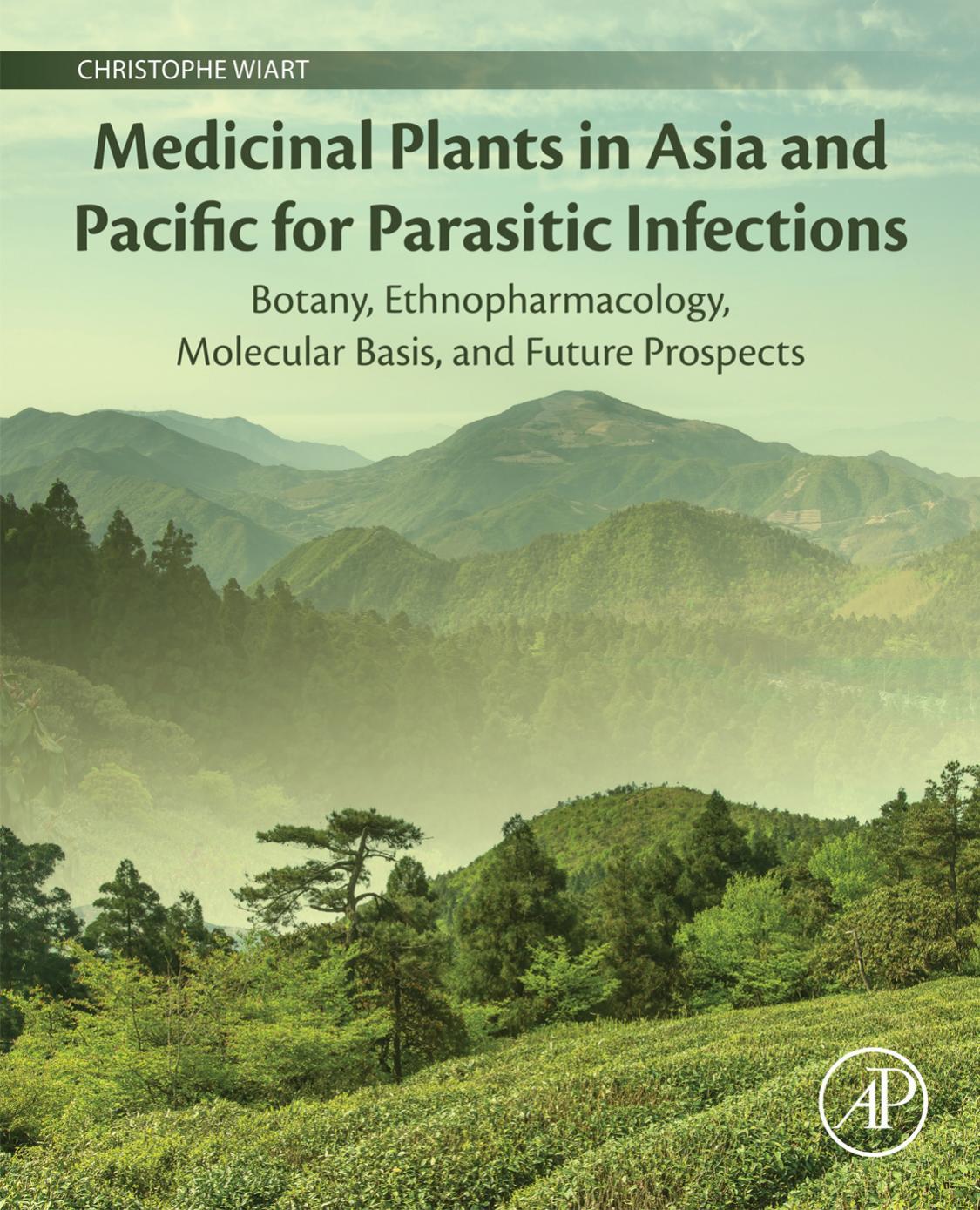HeatStressToleranceinPlants
Physiological,MolecularandGenetic Perspectives
Editedby
ShabirHussainWani
Sher-e-KashmirUniversityofAgriculturalSciencesand TechnologyofKashmir,India
VinayKumar ModernCollege,SavitribaiPhulePuneUniversity,India
Thiseditionfirstpublished2020
©2020JohnWiley&SonsLtd
Allrightsreserved.Nopartofthispublicationmaybereproduced,storedinaretrievalsystem,or transmitted,inanyformorbyanymeans,electronic,mechanical,photocopying,recordingor otherwise,exceptaspermittedbylaw.Adviceonhowtoobtainpermissiontoreusematerialfrom thistitleisavailableathttp://www.wiley.com/go/permissions.
TherightofShabirHussainWaniandVinayKumartobeidentifiedastheauthorsofthiseditorial materialinthisworkhasbeenassertedinaccordancewithlaw.
RegisteredOffice(s)
JohnWiley&Sons,Inc.,111RiverStreet,Hoboken,NJ07030,USA
JohnWiley&SonsLtd,TheAtrium,SouthernGate,Chichester,WestSussex,PO198SQ,UK
EditorialOffice
9600GarsingtonRoad,Oxford,OX42DQ,UK
Fordetailsofourglobaleditorialoffices,customerservices,andmoreinformationaboutWiley productsvisitusatwww.wiley.com.
Wileyalsopublishesitsbooksinavarietyofelectronicformatsandbyprint-on-demand.Some contentthatappearsinstandardprintversionsofthisbookmaynotbeavailableinotherformats.
LimitofLiability/DisclaimerofWarranty
Whilethepublisherandauthorshaveusedtheirbesteffortsinpreparingthiswork,theymakeno representationsorwarrantieswithrespecttotheaccuracyorcompletenessofthecontentsofthis workandspecificallydisclaimallwarranties,includingwithoutlimitationanyimpliedwarranties ofmerchantabilityorfitnessforaparticularpurpose.Nowarrantymaybecreatedorextendedby salesrepresentatives,writtensalesmaterialsorpromotionalstatementsforthiswork.Thefact thatanorganization,website,orproductisreferredtointhisworkasacitationand/orpotential sourceoffurtherinformationdoesnotmeanthatthepublisherandauthorsendorsethe informationorservicestheorganization,website,orproductmayprovideorrecommendationsit maymake.Thisworkissoldwiththeunderstandingthatthepublisherisnotengagedinrendering professionalservices.Theadviceandstrategiescontainedhereinmaynotbesuitableforyour situation.Youshouldconsultwithaspecialistwhereappropriate.Further,readersshouldbe awarethatwebsiteslistedinthisworkmayhavechangedordisappearedbetweenwhenthiswork waswrittenandwhenitisread.Neitherthepublishernorauthorsshallbeliableforanylossof profitoranyothercommercialdamages,includingbutnotlimitedtospecial,incidental, consequential,orotherdamages.
LibraryofCongressCataloging-in-PublicationData
Names:Wani,ShabirHussain,editor.|Kumar,Vinay(Biotechnologist), editor.
Title:Heatstresstoleranceinplants:physiological,molecularand geneticperspectives/[editedby]ShabirHussainWani,VinayKumar. Description:Firstedition.|Hoboken,NJ:JohnWiley&Sons,Inc.,2020. |Includesbibliographicalreferencesandindex.
Identifiers:LCCN2019032800(print)|LCCN2019032801(ebook)|ISBN 9781119432364(cloth)|ISBN9781119432395(adobepdf)|ISBN 9781119432388(epub)
Subjects:LCSH:Plants--Effectofheaton.|Plants--Effectofstresson.| Vegetationandclimate--Research.
Classification:LCCQK755.5.H432020(print)|LCCQK755.5(ebook)|DDC 581.4/2--dc23
LCrecordavailableathttps://lccn.loc.gov/2019032800
LCebookrecordavailableathttps://lccn.loc.gov/2019032801
CoverDesign:Wiley
CoverImages:Miazeplantdamaged©AphakornFuengtee/Shutterstock,DNAstructureisolated ©andreacrisante/Shutterstock
Setin10/12ptWarnockProbySPiGlobal,Chennai,India
PrintedandboundbyCPIGroup(UK)Ltd,Croydon,CR04YY 10987654321
Contents
ListofContributors xiii
Foreword xix
AbouttheBook xxi
AbouttheEditor xxiii
1HeatToleranceinCotton:Morphological, Physiological,andGeneticPerspectives 1 MuhammadTehseenAzhar,ShabirHussainWani, MuhammadTaneesChaudhary,TariqJameel, ParwinderKaur,andXiongmingDu
1.1Introduction 1
1.1.1MorphologicalandPhysiologicalTraits 2
1.1.1.1SeedlingandRootGrowth 3
1.1.1.2StomatalConductance 3
1.1.1.3CellMembraneThermostability 4
1.1.1.4CanopyTemperature 5
1.1.1.5ChlorophyllContent 6
1.1.2GeneticsandMolecularBasisofHeatTolerancein Cotton 8
1.1.3ConventionalBreedingApproaches 9
1.1.4ModernMolecularBreedingApproaches 10
1.2ConclusionandFutureProspects 12 References 12
2SeedPrimingasaMethodtoGenerate Heat-stressToleranceinPlants:A Minireview 23
AdityaBanerjeeandAryadeepRoychoudhury
2.1Introduction 23
2.2MechanismofHeatStressInjuryinPlants 24
2.3SeedPrimingGeneratingHeat-stressTolerance 26
2.4Conclusion 27
2.5FuturePerspectives 27 Acknowledgments 28 References 28
3HowEffectiveAreStress-associatedProteins inAugmentingThermotolerance? 33 InèsKarmousandSandeepKumarVerma
3.1Introduction 33
3.1.1HeatShockProteins(HSPs) 34
3.1.2Proline 36
3.1.3Dehydrins(DHNs) 37
3.1.4RoleofMetabolicProteinsinThermotolerance 37
3.2Conclusion 40 References 40
4BiochemicalandMolecularMarkers: UnravelingTheirPotentialRoleinScreening GermplasmforThermotolerance 47
AhmedIsmail,KareemA.Mosa,MunaA.Ali,and MohamedHelmy
4.1Introduction 47
4.2TypesofMarkers 48
4.3MorphologicalMarkers 49
4.4MolecularMarkers 49
4.5BiochemicalMarkers 53
4.6QuantitativeTraitLociforPlant Thermotolerance 54
4.7PlantMetabolitesUnderHeatStress 61
4.8AntioxidantEnzymesandHeatStress 63
4.9Conclusion 68 References 70
5AlterationinCarbohydrateMetabolism ModulatesThermotoleranceofPlantunder HeatStress 77 RoselineXalxo,BhumikaYadu,JipsiChandra, VibhutiChandrakar,andS.Keshavkant
5.1Introduction 77
5.1.1HeatStressandThermotolerance 79
5.1.1.1MorphologicalAlterations 80
5.1.1.2AnatomicalAlterations 80
5.1.1.3PhysiologicalandBiochemical Modifications 81
5.1.1.4CellMembraneIntegrity 82
5.2CarbohydrateasProtectivesMolecules 83
5.2.1Osmolyte 83
5.2.2Thermoprotectant 84
5.3CarbohydratesasSignalingMolecules 85
5.3.1ReproductiveCellDevelopment 85
5.3.2SeedDevelopment 86
5.3.3SeedGerminationandYieldLoss 87
5.4AdverseImpactsofHeatStress 87
5.4.1Photosynthesis 87
5.4.1.1AlteredCarbonAssimilation 88
5.4.1.2ChlorophyllBreakdown 88
5.4.2MajorandMinorCarbohydrate Metabolism 89
5.4.3ExpressionofRegulatoryGenes 89
5.4.4EnzymeActivity 90
5.5MechanismsInvolvedinThermotolerance 93
5.5.1GlucoseandHeat-stressTolerance 93
5.5.2SucroseandHeat-stressTolerance 94
5.5.3FructanandHeat-stressTolerance 95
5.5.4TrehaloseandHeat-stressTolerance 96
5.5.5RaffinoseandHeat-stressTolerance 97
5.6GeneticApproaches/StrategiesforImproving Thermotolerance 97
5.6.1GeneticallyModifiedCropProduction 97
5.6.2TransgenicStrategies 99
5.7ConclusionsandFuturePerspectives 102 References 103
viii Contents
6TranscriptomicstoDissectPlantResponses toHeatStress 117 SagarSatishDatir
6.1Introduction 117
6.1.1TranscriptomeSequencingandExpressionProfilingof GenesInvolvedinHeatStressResponse 119
6.1.1.1Rice(Oryzasativa L.) 119
6.1.1.2Wheat(Triticumaestivum L.) 123
6.1.1.3Maize(Zeamays L.) 125
6.1.1.4Switchgrass(Panicumvirgatum L.)andRyegrass (Loliumperenne L.) 126
6.1.1.5Spinach(Spinaciaoleracea L.) 128
6.1.1.6 Brassicarapa L. 129
6.1.1.7Banana(Musaacuminate Colla) 130
6.2Conclusions 131 References 132
7ProteomicsasaToolforCharacterizingthe AlterationinPathwaysAssociatedwith DefenseandMetaboliteSynthesis 141 ReetikaMahajanandSajadMajeedZargar
7.1Introduction 141
7.2WhatIsProteomics? 142
7.3NeedofProteomicsinPost-genomicEra 143
7.4DifferentBranchesofProteomics 143
7.5TechniquesUsedinQuantitativeProteomics 145
7.5.1Gel-basedandGel-freeMethods 146
7.5.2Label-basedandLabel-freeMethods 149
7.6RoleofProteomicsinStudyingAlterationinPathways AssociatedwithDefenseandMetabolite Synthesis 150
7.7ConclusionandFuturePerspective 156 References 156
8RNAWorldandHeatStressTolerancein Plants 167 UsmanIjaz,MuhammadAmjadAli,HabibullahNadeem, LinTan,andFarrukhAzeem
8.1Introduction 167
8.2PlantmicroRNAs 168
8.3SmallInterferingRNA(siRNA) 177
8.4LongNoncodingRNAs(lncRNAs) 178
8.5CircularRNAs(circRNAs) 179
8.6ConclusionsandFuturePerspectives 180 References 180
9HeatShockProteins:MasterPlayersfor Heat-stressToleranceinPlantsduringClimate Change 189
AnnuYadav,JitenderSingh,KoushleshRanjan,Pankaj Kumar,ShivaniKhanna,MadhuriGupta,VinayKumar, ShabirHussainWani,andAnilSirohi
9.1Introduction 189
9.2ClassificationofHSPs 192
9.2.1HSP100 192
9.2.1.1StructureofHSP100 192
9.2.1.2ModeofAction:TheHSP100ChaperoneCycle 192
9.2.2HSP90 195
9.2.2.1StructureofHSP90 197
9.2.2.2ModeofAction:TheHSP90ChaperoneCycle 197
9.2.3HSP70 198
9.2.3.1StructureofHSP70 198
9.2.3.2ModeofAction:TheHsp70ChaperoneCycle 198
9.2.4HSP60 199
9.2.4.1StructureofHSP60 201
9.2.4.2ModeofAction:TheHsp60ChaperoneCycle 201
9.2.5TheSmallHeatShockProteinFamily(sHSPs) 202
9.2.5.1StructureofsHSP 202
9.2.5.2ModeofAction:SmallHeatShockProteins 203
9.3HSPsExpressionUnderHeatStressCondition 203
9.4ConclusionandFutureProspects 205 References 205
10TheContributionofPhytohormonesinPlant Thermotolerance 213
SonalMishra,MansiBhardwaj,ShaktiMehrotra,AksarAli Chowdhary,andVikasSrivastava
10.1Introduction 213
10.2ProtectantsinHeatStressAlleviation 215
10.2.1Osmolytes 215
x Contents
10.2.2Nutrients 215
10.2.3SignalingMolecules 217
10.2.4Polyamines 217
10.2.5Phytohormones 218
10.3ApplicationofHormonesinHTManagement 218
10.3.1Auxin 219
10.3.2Gibberellin 221
10.3.3Cytokinin 222
10.3.4AbscisicAcid 224
10.3.5Ethylene 225
10.3.6SalicylicAcid 225
10.3.7JasmonicAcid 227
10.3.8Brassinosteroid 228
10.4ConclusionandProspects 229 Acknowledgements 229 References 230
11ExploringIn-builtDefenseMechanismsin PlantsunderHeatStress 239 GiridaraKumarSurabhiandJatindraKumarSeth
11.1Introduction 239
11.2EffectofHeatStressonCropPlants 240
11.2.1HeatStressEffectsonPhysiologyandCell Structures 241
11.2.2HeatStressEffectsonVegetativeStages 242
11.2.3HeatStressEffectsonReproductiveStage 243
11.2.4HeatStressEffectsonYield 243
11.3ThresholdTemperature 244
11.4In-builtDefenseSysteminPlantstoOvercomeHigh TemperatureStress 245
11.4.1AccumulationofThermoprotectants 245
11.4.1.1HeatShockProteins(HSPs) 245
11.4.1.2Proline 246
11.4.1.3Glycinebetaine(GB) 248
11.4.1.4AbscisicAcid(ABA) 249
11.4.1.5SalicylicAcid(SA) 250
11.4.1.6HeatStressEffectsonSecondaryMetabolism 255
11.4.2TranscriptionalRegulation 256
11.4.3RoleofSmallRNAs(miRNAs)inHeat-stress
Tolerance 258
11.5Conclusion 261
Acknowledgement 262 References 263
Index 283
ListofContributors
MunaA.Ali DepartmentofApplied Biology,CollegeofSciences UniversityofSharjah Sharjah, UAE
MuhammadAmjadAli DepartmentofPlant Pathology UniversityofAgriculture Faisalabad, Pakistan
FarrukhAzeem DepartmentofBioinformatics andBiotechnology GovernmentCollege UniversityFaisalabad(GCUF) Faisalabad, Pakistan and
HaikouExperimentalStation ChineseAcademyofTropical AgriculturalSciences (CATAS),HainanKey LaboratoryofBananaGenetic Improvement Haikou,HainanProvince China
AdityaBanerjee DepartmentofBiotechnology St.Xavier’sCollege (Autonomous) Kolkata,WestBengal, India
MansiBhardwaj ICAR-NationalInstitutefor PlantBiotechnology IARICampus,NewDelhi, India
xiv ListofContributors
JipsiChandra SchoolofStudiesin Biotechnology
Pt.RavishankarShukla University
Raipur, India
VibhutiChandrakar SchoolofStudiesin Biotechnology
Pt.RavishankarShukla University
Raipur, India
MuhammadTaneesChaudhary DepartmentofPlantBreeding andGenetics
UniversityofAgriculture
Faisalabad, Pakistan
AksarAliChowdhary DepartmentofBotany
CentralUniversityofJammu
Samba, India
SagarSatishDatir BiologyDepartment Queen’sUniversity
Kingston,ON, Canada and DepartmentofBiotechnology
SavitribaiPhulePune University
Pune,MS, India
XiongmingDu InstituteofCottonResearch ofChineseAcademyof AgriculturalSciences,State KeyLaboratoryofCotton Biology
Anyang,Henan, China
MadhuriGupta CollegeofBiotechnology
SardarVallabhbhaiPatel UniversityofAgriculture& Technology
Meerut,UttarPradesh, India
MohamedHelmy TheDonnelleyCentre UniversityofToronto Toronto,ON, Canada
UsmanIjaz DepartmentofBioinformatics andBiotechnology GovernmentCollege UniversityFaisalabad(GCUF) Faisalabad, Pakistan
AhmedIsmail DepartmentofBiotechnology, FacultyofAgriculture Al-AzharUniversity Cairo, Egypt and
PublicHealthDepartment, CollegeofAppliedMedical Science
MajmaahUniversity
MajmaahCity, KSA
TariqJameel DepartmentofPlantBreeding andGenetics
UniversityofAgriculture
Faisalabad, Pakistan
InèsKarmous BiotechnologyLaboratory, DepartmentofBiology
BoluAbantIzzetBaysal University
Bolu, Turkey
ParwinderKaur
UWASchoolofAgriculture andEnvironment
TheUniversityofWestern Australia
Crawley,WesternAustralia, Australia
S.Keshavkant SchoolofStudiesin Biotechnology
Pt.RavishankarShukla University
Raipur, India and
ListofContributors xv
NationalCenterforNatural Resources
Pt.RavishankarShukla University
Raipur, India
ShivaniKhanna CollegeofBiotechnology
SardarVallabhbhaiPatel UniversityofAgriculture& Technology
Meerut,UttarPradesh, India
PankajKumar CollegeofBiotechnology
SardarVallabhbhaiPatel UniversityofAgriculture& Technology
Meerut,UttarPradesh, India
VinayKumar DepartmentofBiotechnology ModernCollegeofArts, ScienceandCommerce, SavitribaiPhulePune University,Pune, India
ReetikaMahajan Govt.DegreeCollegePoonch JammuandKashmir, India
xvi ListofContributors
ShaktiMehrotra DepartmentofBiotechnology InstituteofEngineeringand Technology
Lucknow, India
SonalMishra SchoolofBiotechnology UniversityofJammu Jammu, India
KareemA.Mosa DepartmentofBiotechnology, FacultyofAgriculture Al-AzharUniversity
Cairo, Egypt and DepartmentofApplied Biology,CollegeofSciences UniversityofSharjah
Sharjah, UAE
HabibullahNadeem DepartmentofBioinformatics andBiotechnology GovernmentCollege UniversityFaisalabad(GCUF) Faisalabad, Pakistan
KoushleshRanjan DepartmentofVeterinary PhysiologyandBiochemistry CollegeofVeterinaryand AnimalSciences,Sardar VallabhbhaiPatelUniversity ofAgricultureand Technology
Meerut,UttarPradesh, India
AryadeepRoychoudhury DepartmentofBiotechnology St.Xavier’sCollege (Autonomous)
Kolkata,WestBengal, India
JatindraKumarSeth PlantMolecularBiologyand ‘OMICS’Laboratory RegionalPlantResource Centre
Bhubaneswar,Odisha, India
JitenderSingh CollegeofBiotechnology SardarVallabhbhaiPatel UniversityofAgriculture& Technology
Meerut,UttarPradesh, India
AnilSirohi CollegeofBiotechnology
SardarVallabhbhaiPatel UniversityofAgriculture& Technology
Meerut,UttarPradesh, India
VikasSrivastava DepartmentofBotany CentralUniversityofJammu Samba, India
GiridaraKumarSurabhi PlantMolecularBiologyand ‘OMICS’Laboratory RegionalPlantResource Centre
Bhubaneswar,Odisha, India
LinTan HaikouExperimentalStation, ChineseAcademyofTropical AgriculturalSciences (CATAS)
HainanKeyLaboratoryof BananaGeneticImprovement
Haikou,HainanProvince, China
MuhammadTehseenAzhar DepartmentofPlantBreeding andGenetics UniversityofAgriculture Faisalabad, Pakistan
ListofContributors
SandeepKumarVerma BiotechnologyLaboratory, DepartmentofBiology
BoluAbantIzzetBaysal University
Bolu, Turkey
ShabirHussainWani MountainResearchCentre forFieldCrops
Khudwani,Sher-e-Kashmir UniversityofAgricultural SciencesandTechnologyof Kashmir
JammuandKashmir, India
RoselineXalxo SchoolofStudiesin Biotechnology
Pt.RavishankarShukla University
Raipur, India
AnnuYadav CollegeofBiotechnology
SardarVallabhbhaiPatel UniversityofAgriculture& Technology
Meerut,UttarPradesh, India
xviii ListofContributors
BhumikaYadu SchoolofStudiesin Biotechnology
Pt.RavishankarShukla
University
Raipur, India
SajadMajeedZargar DivisionofPlant Biotechnology
Sher-e-KashmirUniversityof AgriculturalScienceand TechnologyofKashmir
Shalimar,Srinagar, JammuandKashmir, India
Foreword

Oneoftheprevalentenvironmental stressesencounteredbyplantsduringtheirimportantgrowthstagesis heatstress.Exposuretoheatstress forprolongedperiodscanevenresult inplantdeath.Plantscanbedamagedbyeitherhighdayorhighnight temperaturesandbyeitherhighair orhighsoiltemperatures.Predictions indicatethattemperatureswillintensifybyanother2–6 ∘ bytheclimaxof thiscenturywhichwillincreasethelikelihoodofmorefrequentandmoresevereheatstressinplants,begettingaserious reductionincropyields.Thegeneticbasisofheatstressadaptationispoorlyunderstood.Conventionalbreedingmethodshave metwithlimitedsuccessinimprovingtheheat-stresstolerance ofimportantcropplantsthroughinterspecificorintergeneric hybridization.Therefore,itisimperativetoaccelerateeffortsfor unravelingthebiochemical,physiological,andmolecularmechanismsunderlyingheat-stresstoleranceinplants.Heatstress caninducediversephysiologicalandmolecularresponsesin plantsthatleadtothedisturbanceofvariouscellularmetabolic processes,impairmembranestability,causeproteindenaturationandthermalaggregation,andconsequentlyaffectplant growthanddevelopment.Theheatstressresponseisalsoillustratedbytheinhibitionofregulartranscriptionandtranslation, elevatedexpressionofheatshockproteins(HPSs),andinductionofheattolerance.Recentadvancesinmoleculargenetics
Foreword
approacheshaveprovidednewinsightsintotheplantheatstress response.TheQTL-basedapproachesallowlocitobeidentified formarkersthatarelinkedtoheattolerance.Further,discovery ofnovelgenesandpathways,analysesofexpressionpatterns, andthedeterminationoffunctionofthesegenesduringheat stressadaptationwillofferabasisforefficientengineeringstrategieswiththeaimtoenhanceheatstresstoleranceinplants.
Iamdelightedthattheeditedvolume Heat-StressTolerance inPlants:Physiological,MolecularandGeneticPerspectives is beingpublished.Thechaptersincludedinthisbookarenicely writtenbyscientistsandresearchers.Thisbookdescribesrecent advancesinheat-stresstoleranceutilizinggeneticandgenomic approachesandtheirapplicationinimportantagricultural crops.Recentadvancementsinplantomicsandtheirimportanceandapplicationinthedevelopmentofheat-stress-tolerant cropshavealsobeenincluded.
Icongratulatetheeditorsforunravellingthisvolumeandhope thatthiswillbeausefulreferencematerialforresearchers,students,andpolicymakers.
9thMay2019
NewDelhi
T.Mohapatra
AbouttheBook
Theglobalpopulationis7.3billionandby2050itisexpectedto reach9.7billion,whileatthesametimeagriculturalproductivityisnotincreasingwiththesamespeed,owingtothemounting environmentalconstraintsasaresultofclimatechange.Heat stress,whichcanbedefinedasaperiodinwhichtemperatures arehotenoughforasufficientperiodoftimetocauseirreversible damagetoaplant’sfunctionordevelopment,isoneofthemajor environmentalstresseshamperingplantgrowthandproductivityseverely.Theprojectionsabouttheincreaseinglobalambient temperaturesoverthenextfewdecadesareexpectedtoincrease theintensityoftheimpactofheatstressonplants.
Owingtolimitedgeneticbasisforplantheatstressresponses andtolerancebesideslimitedsuccessofconventionalbreedingapproaches,adeeperunderstandingofthemechanisms underlyingplants’responsestoheatstressisneeded.Recent investigationsconfirmedthatheatstressinhibitstranscription andtranslation,andincreasesthelevelsofheatshockproteins(HSPs).Duringextremeheatstressconditions,signaling pathwaysleadingtoapoptoticcelldeatharealsoactivated.As molecularchaperones,HSPsofferprotectiontocellsagainst thedestructiveeffectsofheatstressandaugmentsurvival.The improvedexpressionofHSPsisregulatedbyheatshocktranscriptionfactors(HSFs).Severalrecentadvancesinidentifying gene(s)and/orpathwaysandtheirrolesinheatstressresponses andtolerancehaveofferedopportunitiesforresearchersto explorethesegene(s)forengineeringheat-stresstolerancein majorcrops.Studiesinvolvingfullgenomeprofiling/sequencing, andmutationalandtransgenicplantanalyseshaveprovideda
xxii AbouttheBook
deepinsightofthecomplextranscriptionalmechanismthat operatesunderheatstress.
Throughthisbook,weintendtointegratethecontributions frompotentialplantscientiststargetingheat-stresstolerance mechanismsusingphysiological,biochemical,molecular,and geneticapproaches.
AbouttheEditor
Dr.ShabirHussainWani isseniorAssistantProfessorat MountainResearchCentreforFieldCrops,Khudwani–192101, Sher-e-KashmirUniversityofAgriculturalSciencesandTechnologyofKashmir,JammuandKashmir,India.Hereceived aPhDinplantbreedingandgeneticson“transgenicricefor abioticstresstolerance”fromthePunjabAgriculturalUniversityLudhiana,India.AfterobtaininghisPhD,heworkedasa researchassociateintheBiotechnologyLaboratory,Central InstituteofTemperateHorticulture(ICAR),Srinagar,India.He thenjoinedtheKrishiVigyanKendra(FarmScienceCentre)as programcoordinatoratSenapati,Manipur,India.Heteaches coursesrelatedtoplantbreeding,seedscienceandtechnology,andstressbreeding,andhaspublishedmorethan100 papers/chaptersinjournalsandbooksofinternationaland nationalrepute.Heservedasguesteditorandreviewseditorfor thejournal FrontierinPlantScience (2015–2018).Hehasalso editedseveralbooksoncurrenttopicsincropimprovement forabioticstresstolerancepublishedbySpringerNatureand CRCPress.HisPhDresearchfetchedfirstprizeintheNorth ZoneCompetition,atnationallevel,inIndia.Hewasawarded YoungScientistAwardfromtheSocietyforPromotionofPlant Sciences,Jaipur,India,in2009.HeisafellowoftheSocietyfor PlantResearch,India.Recently,healsoreceivedYoungScientistAward(Agriculture)2015fromSocietyforPlantResearch, Meerut,India.HealsoservedasvisitingScientistatDepartment ofPlantSoilandMicrobialSciences,MichiganStateUniversity, USAundertheUGCRamanPostDoctoralFellowshipprogram.
xxiv AbouttheEditor
Currently,heisinchargeofWheatimprovementprogramat MRCFCKhudwaniSKAUSTKashmir.
Dr.VinayKumar isanAssociateProfessoratthePostgraduateDepartmentofBiotechnology,ProgressiveEducation Society’sModernCollegeofArts,ScienceandCommerce, Ganeshkhind,Pune,IndiaandaVisitingFacultyattheDepartmentofEnvironmentalSciences,SavitribaiPhuleUniversity, Pune,India.HeobtainedhisPhDinBiotechnologyfrom SavitribaiPhulePuneUniversity(formerlyUniversityofPune) in2009.ForhisPhD,heworkedonmetabolicengineeringof riceforimprovedsalinitytolerance.Hehaspublishedmore than40peer-reviewedresearch/reviewarticles,contributed 18bookchaptersandedited4booksincludingthis,published bySpringerandWiley.HeisarecipientoftheGovernmentof India’sScienceandEngineeringBoard,DepartmentofScience andTechnology(SERB-DST)YoungScientistAwardin2011. Hiscurrentresearchinterestsincludeelucidatingmolecular mechanismsunderlyingsalinitystressresponsesandtoleranceinplants.Hisresearchgroupisengagedindeciphering themolecularmechanismsresponsibleplantabioticstress tolerance.
HeatToleranceinCotton:Morphological, Physiological,andGeneticPerspectives
MuhammadTehseenAzhar 1 ,ShabirHussainWani 2 , MuhammadTaneesChaudhary 1 ,TariqJameel 1 , ParwinderKaur 3 ,andXiongmingDu 4
1 DepartmentofPlantBreedingandGenetics,UniversityofAgriculture,Faisalabad, Pakistan
2 MountainResearchCentreforFieldCrops,Khudwani,Sher-e-KashmirUniversityof AgriculturalSciencesandTechnologyofKashmir,JammuandKashmir,India
3 UWASchoolofAgricultureandEnvironment,TheUniversityofWesternAustralia, Crawley,WesternAustralia,Australia
4 InstituteofCottonResearchofChineseAcademyofAgriculturalSciences,StateKey LaboratoryofCottonBiology,Anyang,Henan,China
1.1Introduction
Cottonbelongingstothegenus Gossypium andfourspecies, namely G.hirsutum L., G. barbadense L., G.arboreum L.,and G.herbaceum L.,thatweregrownindependentlyforthepurpose oftextilefiber(Fryxell1992).Cottonismainlygrownintropical andsub-tropicalareashavingtemperaturesvaryingfrom40to 45 ∘ C(Ashrafetal.1994).Thephenologicaldevelopmentand accumulationofplantbiomassdependupontemperatureduring itsgrowingseason(Echeretal.2014).Cottonshedsitsflowers andsquareswhenthetemperaturereaches36 ∘ C(Reddyetal. 1991).Theplantreproduction,metabolism,andproductivity ofcottonareadverselyaffectedbyhigh-temperaturestress (Demireletal.2014).Theresponseofplantstoheatstress dependsuponthedurationanddegreeofheatstress(Hasanuzzamanetal.2013).Furthermore,high-temperaturestressis closelyrelatedtowaterdeficitandcanbefurtherexacerbated bylimitedorunreliableavailabilityofwaterincotton-growing
HeatStressToleranceinPlants:Physiological,MolecularandGeneticPerspectives, FirstEdition. EditedbyShabirHussainWaniandVinayKumar. ©2020JohnWiley&SonsLtd.Published2020byJohnWiley&SonsLtd.
areas(Rizhskyetal.2004).Thepresenceofgeneticvariation withinaspeciesisaprerequisiteforabreedingprogramforthe developmentofgenotypesresponsivetoheatstress(Azharetal. 2009).Allmetabolicandbiochemicalactivitiesofplantsrequire anoptimumtemperaturerange,whichistermedthethermal kineticwindow(TKW).Planttemperatureshouldbewithin rangeoftheTKW.Theplantcomesunderheatstressifits temperaturegoesbeloworaboveTKW.ATKWof23.5–32 ∘ C isrequiredforproperplantgrowth(Sawanetal.2009).Plant breedersarecontinuallyscreeningcottongermplasmforheat stressduetoclimatechange.Likeotherphysiologicaltraits, seedcottonyield(SCY)isconsideredabeneficialtraitforthe developmentofcottongermplasmagainsthightemperature butitiscomplex,andaffectedbyclimaticconditions,andso requiresveryspecializedbreedingprograms,buteventhenone cannotavoidenvironmentalvariations(Dem ˙ Ireletal.2016). Hightemperatureexertsnegativeimpactduetoinhibition ofphotosynthesisprocess(DeRidderandSalvucci2007).The modificationsinducedbyhightemperaturemaybedirect, owingtochangesinthephysiologicalprocess,orcanbeindirect byalteringthedevelopmentalpatterns.Forexample,developing seedsmaybeaffectedbyheatstressthatmaydelaythegerminationorlossofvigor.Ultimatelyitwillleadtoreducedemergence andseedlingestablishment(Wahidetal.2007).Theexposureof cottontohightemperaturecausessheddingof35%premature flowerand50–75%ofbollsinvariableclimaticconditions.
1.1.1MorphologicalandPhysiologicalTraits
Oneofthemosteconomicalandsuitablewaystomitigatethe adverseeffectsofheatstressistodeveloporidentifyheattolerantcultivars.Undervariousheatstressregimes,plants exhibitdifferentkindsofsurvivalmechanism,whichinclude variousheatstressavoidancemechanisms,phonologicalalterationslikevariableleafangle,transpirationalmechanism,or changesinlipidmembranecomposition,andvariousmorphologicalchanges(Niinemets2010).Plants’stomataclosing mechanism,reducedwaterloss,largerstomatalandtrichomatousdensitiesandwideningxylemvesselsarethemostcommon
approachesfollowedbytheplantunderdifferentconditionsof heatstress(Hasanuzzamanetal.2013).
Researchworkabouttheuseofvariousplantandphysiological traitsisreviewedintheproceedingparagraphs.
1.1.1.1SeedlingandRootGrowth
Thegerminationanddevelopmentofseedlingsofcropplants dependuponremainingwiththeoptimumtemperaturerange of28to30 ∘ C.Thebasetemperatureisabout12 ∘ Cforseed germinationand15.5 ∘ Cforseedlinggrowth.Cooltemperature between2and4 ∘ Cisamajorprobleminvariousplacesin theUnitedStates,mainlyacrosstheDeltaregionofMississippiduringgerminationandinitialgrowthoftheseedlings. Genotypicdifferenceshavebeenobservedforgermination androotdevelopmentundercoolsoiltemperatures(Mills etal.2005).WhileatthetimeofsowinginnorthernIndia,the windvelocityandsoiltemperatureareveryhigh,resultingin arapidlossofsoilmoisture(Latheretal.2001).McMichael andBurke(1994)revealthatsoilwithatemperaturerangeof between20and32 ∘ Cissuitableforproperrootgrowthand development.Roottemperaturestressrangesbetween35and 40 ∘ Candbadlyaffectsthehydraulicconductivityandnutrient uptakeabilityoftheplantandcauseslowhormonesynthesis, andbadlyaffectshormonetransportation(ClarkandReinhard 1991;BurkeandUpchurch1995).Synthesisofcytokininswhich originatepredominantlyinrootsisamongthemostsensitive processes(Paulsen1994).Manyfunctionsofroots–comprising theuptakeofnutrientsandwater,assimilationandsynthesisofmetabolites,andtranslocation–areverysensitiveto temperature.Roottemperaturemaybemorecriticalthan shoottemperaturesforplantgrowthbecauserootstoleratea shorterrangeoftemperatureandarelessadaptabletoextreme variations(Nielsen1974).
1.1.1.2StomatalConductance
Stomatalclosurestoreducetranspirationratesalsoreducephotosynthesisrates.Increasedstomatalconductancehelpswith thecoolingofleavesbyevaporationandtherebyreducesthermalstress.Optimumtemperaturesof < 30 ∘ Cduringdaytimein uplandandPimacottonarewellbelowcommonlyoccurringair
temperaturesinmostcotton-growingareas(Radinetal.1994). Stomatalconductanceandnetphotosynthesisareinhibitedby moderateheatstressinmanyplantspecies,owingtodecreases intheactivationstateofrubisco(Crafts-BranderandSalvucci 2002;Moralesetal.2003).Stomatacouldbeexploredforthe developmentofheattoleranceincropplantsbecausetheyregulatethetranspirationrateanddeterminethedegreetowhich waterevaporationcancooldowntheleaves.Ifstomataopen widerinhigher-yieldinglines,transpirationmaybeincreased andphotosyntheticratesimprovedbecauseCO2 aswellas watervaporsmustdiffusethroughthestomata.Abroader examinationof16speciesperformedbyMonteith(1995) supportedthetheorythatstomatarespondnottohumidity levelsbuttorespirationrates.Moneith(1995)alsoidentified thatstomatafromallinvestigatedspecieshadpatchystomata closureinresponsetoincreasedrespirationratestolimitwater loss.Manystudieswereintendedtoassessthegermplasmof cottonandwheatbyusingstomatalconductanceandphotosynthesisascriteriafortheidentificationofheat-tolerant genotypes(Cornishetal.1991;Luetal.1998;Ulloaetal.2000; Rahman2005).
1.1.1.3CellMembraneThermostability
Theconventionalscreeningmethodsoflargegermplasmare timeconsumingandlaboriousbutthesuccessofanybreeding programdependsoneffectiveevaluationtechniques(Asha andLalAhamed2013).Cellmembranethermostability(CMT) protocolhasbeensuggestedbySullivan(1972)asadependablemethodformeasuringheattolerancebyquantifyingthe amountofelectrolyteleakagefromleafdisksafterexposure toheatstress,andthistechniquehasbeenusedefficiently inpotato(Coriaetal.1998),rice(Maavimanietal.2014), tomato(Golametal.2012),soybean(Martineauetal.1979), wheat(Blumetal.2001),sorghum(Marcum1998),andbarley (WahidandShabbir2005).Membranethermostabilityhasbeen reportedtohaveastronggeneticcorrelationwithgrainyieldin wheat.Heritabilityofmembranethermostabilityinmaizewas estimatedtobe73%.CMThasbeenusedincottonasasuitable screeningandselectioncriterionforheattolerance,owingto itsabilitytodistinguishheat-sensitiveand-tolerantgenotypes
